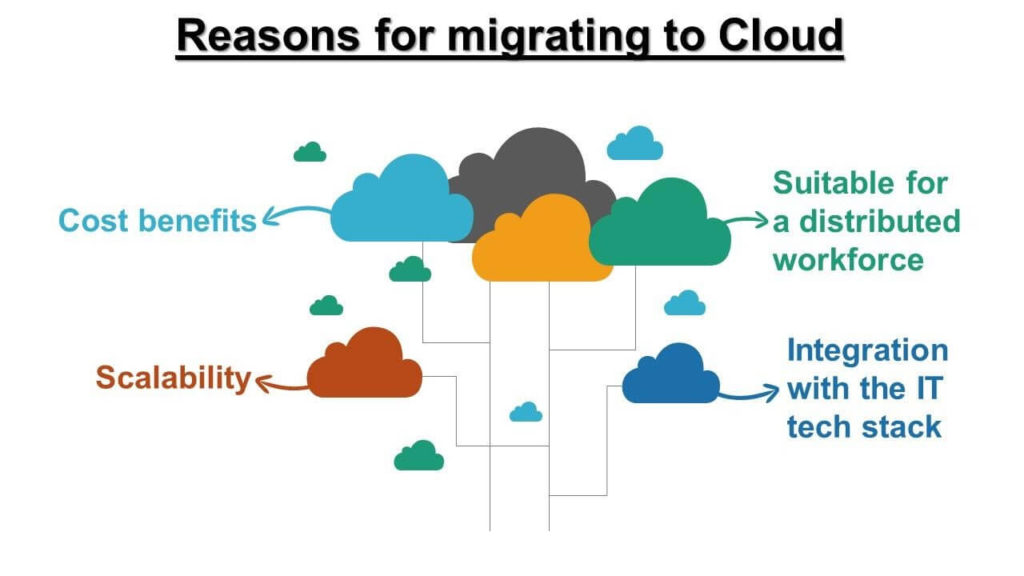
Cloud migration is the process of moving applications, processes, data, and other related components from on-premises servers to a cloud-based infrastructure.
Advancement in technology in the past few years has led more and more businesses to move their products and applications to a native cloud setup. Cloud migration helps in reducing an organization’s operational and infrastructural costs, thus improving the effectiveness of the overall development and deployment process. This move makes way for the teams to focus on addressing the demand for faster time to market with improved quality.
Our article will walk you through the benefits attached with cloud migration, followed by the challenges that it poses, along with the ways to overcome those challenges.
“Worldwide end-user spending on public cloud services is forecast to grow 18.4% in 2021 to total $304.9 billion, up from $257.5 billion in 2020” – Gartner, Inc.
In the year 2020, the Covid-19 crisis had given rise to the need for remote connectivity. Organizations in various sectors set aside a good portion of IT expenditure to address the remote working needs and to keep the wheels rolling for their business. However, even before the pandemic, the cloud was in high demand due to the benefits it provides for overall business growth.

Cloud migration comes with its own set of challenges. If not executed properly, it may incur losses instead of adding any business value. The following table gives a short summary of common hurdles in the journey of migration, followed by a detailed explanation.
| Challenge | Summary |
| Initial setup cost | The cost incurred initially for the setup and recurring costs can be a decisive factor for cloud migration |
| Validating the stages of cloud migration | Every stage of migrating the application to the cloud has to be validated carefully for continuous availability and correct functionality |
| Vendor Lock-in issues | Switching between cloud vendors is not that easy, as it involves additional cost and loss of time and resources. |
| Workforce related issues | Accepting the change by the teams is a common challenge that organizations have to deal with |
| Business value | Clarity on why migration is being done and its overall business value have to be carefully listed down to prepare a comprehensive migration plan. |
Initial setup cost
Overall financial implications of cloud migration can be a decisive factor. Cloud migration reaps benefits in the long term, by reducing the maintenance and infrastructure costs with improved processes and efficiency. However, there are initial investments that are needed, which include:
These costs can act as a deterrent for budget-conscious organizations.
Solution
The business decision-makers should work in tandem with the technical team to identify the initial costs involved and day-to-day expenses. Key performance indicators for cloud migration should also be established and checked regularly. Evaluating the costs and weighing them against the KPI’s regularly gives a good idea of the success of cloud migration and also indicates problems if any. These numbers will aid in regulating the expenses as per the budget earmarked for migration.

Validating the stages of cloud migration
Due to the initial efforts and costs involved, many organizations tend to opt for an incremental approach towards cloud migration. Migrating stagewise can pose certain challenges since every stage has to be validated for the operability and continuous availability of systems with correct functionality. This is compounded by the fact that there could be multiple applications at different scales, small, medium, or large, that need to be validated. Besides this, migrating all the system operations and transferring zettabytes of data is not an easy feat.
Solution
It is a good idea to conduct an IT audit for identifying the scope of cloud migration to define a proper strategy that outlines the costs and process of migration. It is prudent to ensure that all the integration points for databases, third-party tools, application gateways, etc have been accounted for. Also, having an overlap of operations on-premises and on the cloud will address the issue of continuity.
Webomates provides a seamless migration to the cloud ensuring smooth operability with no or minimal impact.
One of our prestigious clients had a cloud migration challenge at hand. Read more about it on our website by clicking here. We helped them in managing migrations for around 140 applications, including SAP, that was impacted by the migration. Many of these applications, if impacted, would have cost them dearly.
Vendor lock-in issues
Many organizations are concerned about being locked into a single cloud platform. It stems from the fact that portability is at stake in many cases, especially for legacy applications. Sometimes, organizations may want to switch the cloud vendor due to multiple reasons but are deterred due to the clauses in SLAs or because of the lengthy and expensive process for changing the vendor.
Solution
It is a good idea to research the vendor policies, services, and contract renewals before making final decisions regarding migration. Another option is to put an exit clause in the SLA. In either case, it is good to have a technical exit strategy in place, which includes improving portability of data, code, and processes, including detailed documentation.
Workforce related issues
It is a human tendency to resist any change. Cloud migration brings its own sets of roadblocks, like technology changes and revised work strategy, which may lead to discontentment among the teams.
Solution
Addressing the employee concerns, educating them about the changes, and training them suitably to rise to the challenge is the best way to handle such a situation.
Business value
Cloud migration is a key turning point for any organization. While it is important to work on the “how” of migration, it is equally important to understand “why” too. Lack of clarity on why migration is being done may prove disastrous in the long run.
Solution
Analyzing the need for cloud migration and listing down its business value and ROI is an important step. It is important to take into account the current infrastructure, process, and skillset while defining a robust migration strategy.
Businesses migrating to the cloud is the new normal now. It has become more of a necessity these days to have an edge in this highly competitive world. Cloud migration has opened the doors of opportunities for organizations to leverage ready accessibility, scalability, and collaborative capabilities, thereby reducing overhead costs and providing increased efficiency.
Webomates provides Testing as a service with a hybrid model of automated, crowdsourced, and load testing system in the cloud setup.
Our team is well versed in various cloud technologies. The entire dev team, as well many team members of the testops team are AWS certified and are well equipped with the necessary knowledge needed to execute testing services with ease.
At Webomates, we work relentlessly to evolve our platform and processes to provide guaranteed execution, which takes testing experience to an entirely different level, thus ensuring a higher degree of customer satisfaction.
If you are interested in learning more about Webomates’ CQ service please click here and schedule a demo, or reach out to us at info@webomates.com
Tags: AWS, Cloud migration, Cloud testing
Test Smarter, Not Harder: Get Your Free Trial Today!
Start Free Trial
Leave a Reply